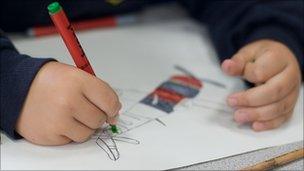Teaching Gaelic 'needs written guidance', HMIE say
- Published

The HMIE said a range of subjects should be taught in Gaelic
The teaching of Gaelic at Scottish schools needs written national guidance, Her Majesty's Inspectorate of Education (HMIE) has suggested.
In a review of Gaelic education, inspectors said such guidance to define best practice was lacking.
They said variations in learning Gaelic were "too great" and could "impact adversely" on children's progress.
But the HMIE added that Scotland had the potential to lead Europe in the promotion of minority languages.
In the newly-published report, external, inspectors said that in 2010-11 there were about 2,000 pre-school children and 2,312 primary pupils learning Gaelic.
They said growing numbers of youngsters entering Gaelic education did not already have it as their first language.
A large percentage of children were also from homes where the language was not spoken.
The HMIE said Gaelic had been a growth area in pre-school and primaries in the past 25 years.
However, inspectors identified different interpretations by schools of how the two early stages of Gaelic learning, known as total immersion and immersion, should be approached.
They said at some schools subjects outwith learning to talk and write in Gaelic were not also taught in the language, but in English.
The HMIE has recommended the introduction of written national guidance.
In the report, inspectors said: "There is no written national guidance for Gaelic-medium education which defines best practice in delivering Gaelic-medium provision.
"Such guidance would be useful for practitioners, parents, policy makers and providers."
Inspectors added: "It could underpin the potential Scotland has to become an international model of best practice in the promotion of minority language communities across Europe."
- Published17 November 2010
- Published1 November 2010
- Published13 September 2010